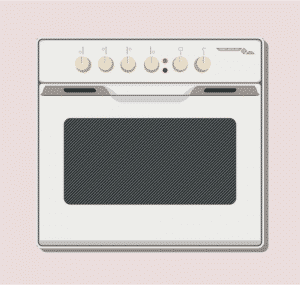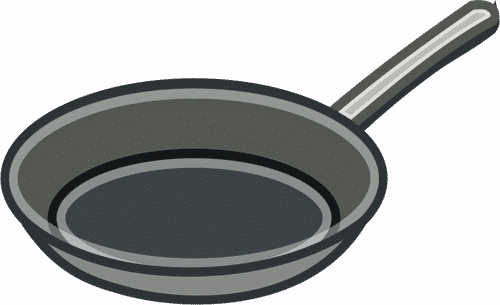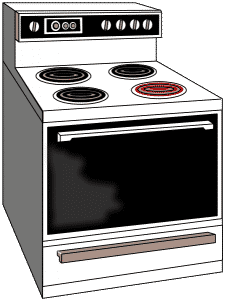Roasting your own coffee beans at home is all about taking your coffee experience to the next level. Having access to freshly roasted coffee beans is one of the most important reasons people start home roasting. Taking full control of the whole process behind making a great cup of coffee (except for growing the coffee cherries) is another.
Whatever your reason is, if you want to learn more about roasting coffee beans at home, you have come to the right place.
Why do coffee beans need to be roasted?
Coffee beans are the seeds from the coffee cherry. When coffee cherries are processed, the skin and pulp are removed (sometimes after some sort of fermentation and drying process). Then you are left with the raw coffee beans, which are most commonly known as green coffee beans. The green coffee beans themselves aren’t much use. The only way green coffee beans are used is in the hyped (and very improbable) green coffee diets.
Coffee beans are roasted to make them suitable for consumption, and – more importantly – to bring out all the delicious flavors and aromas. By exposing coffee beans to heat, the so-called Maillard reaction browns and transforms the bean. This transformation has both a chemical and physiological result. More on that later. What you need to remember is that the roasting process largely determines the flavor and aroma in the final stage: the brewing of a cup of coffee.
What happens during the coffee roasting process?
During the coffee roasting process, the roaster tries to manipulate the transfer of heat to the coffee beans. By adjusting things like temperature, airflow, drum rotation speed, amount of coffee beans roasted in one session, and – probably the most crucial factor – the time the coffee bean is exposed to the heat.
Every adjustment the roaster makes can have a massive effect on the end result. Roasters use visual cues (i.e., the development of color), the sound beans make during the process, and the smell the beans give off to judge how the coffee beans are coming along. By watching the beans change color, listening out for the cracking and popping sound they make as they release gasses, and inhaling the lovely fumes caused by the roasting, they gauge whether the roasting is done or not.
The stages of the coffee roasting process
As we will discuss later on in this article, roasting coffee beans is has the characteristics of an artistic process, rather than a scientific one. Nonetheless, there are stages in each roasting process, which can be described as follows:
The green or unroasted stage
When the green coffee beans are not yet roasted, they are green. Once the heat is introduced, the real roasting of the beans will start.
The drying stage
The coffee beans start to release steam when the heat is applied. This removes most of the residual moisture in the bean. During this first stage, the coffee beans turn from their original green color to a brownish-yellow. The beans smell like grass, bread, and/or burlap during this stage.
The first development stage
The coffee beans begin to give off a more familiar coffee smell while turning light brown. During this stage, the coffee beans start to smoke.
The stage of the first crack
When the heat penetrates deep into the coffee beans, the real roasting begins, and the fibers of the coffee bean split. This makes a loud cracking noise, a bit like popping popcorn.
The second development stage
From here, the beans begin to expand and darken as they caramelize.
The stage of the second crack
In this stage, the expanding of the coffee bean makes a sound. Unlike the first crack, it doesn’t sound like popcorn popping. It’s much quieter, like crushing paper. Soon after this second crack, the coffee beans darken quickly and start to smoke. Time to stop roasting!
The stage of the burnt coffee bean
For most specialty coffee beans (single-origin and the like), it is best to stop roasting between the second development stage and the beginning of the second crack. Most beans are burnt when they pass the second crack. Coffee made with burnt coffee beans tastes horrible. Like a combination of rubber and charcoal.
Depending on the judgment of the roaster, the roasting process can be stopped at any time after the end of the stage of the first crack. But, as said, it is essential to stop roasting before the beans are well into the second crack.
As you can probably guess, a good coffee roaster knows when to stop the roasting process. The goal is to get the best out of the coffee bean. The ability to determine which level of ‘roastedness’ amplifies the desirable flavor compounds and aromatics in the coffee bean, shows the skill of the coffee roaster.
A lot of professional coffee roasters use high tech machinery to determine the level of ‘roastedness’ and to ensure consistency between batched. Machines like Argtron’s coffee roast analyzers have made the life of the professional coffee roaster considerably easier. The device uses “near-infrared abridged spectrophotometers” (whatever that means) to measure the color of the bean and spits out a number. These numbers refer to a scale that has become the standard for classifying roast levels among coffee roasting professionals. The lower the number, the darker the roast.
But these devices are not within reach for most home coffee roasters.
So the question remains: how to roast coffee beans at home?
How to roast coffee beans at home?
Up until the beginning of the twentieth century, most coffee that was drunk at home was also roasted at home. After World War I, coffee became a commodity that was produced in an industrial environment. Mass production turned coffee from a relative luxury product into a beverage everyone could enjoy every day.
The major downside to the industrialization of coffee was that we lost touch with the concept of freshness. As with many mass-produced products, convenience triumphed over quality.
With the revival of specialty coffee in the last 25 years or so, the emphasis on quality returned. The freshness of coffee became prominent once again. And because roasting coffee beans at home was once the norm, there is no reason you shouldn’t be able to do it. Do it like the old-timers!
In this article, you’ll find all the information to get you started in roasting coffee beans at home. But this article is by no means complete. If you are serious about home roasting, and you are ready to take the next step, please check out the resources at the end of this article.
Before diving into the ‘how to’ of roasting coffee at home, let first ask ourselves one important question.
Is it worth roasting at home?
Do you want to impress that significant other you just invited up for coffee? Or to completely floor that couple from your kid’s school when they come to dinner? Imagine pulling out a batch of beans with an, “Oh, these? Oh, no big deal, I just sourced these from a little place in Kenya and roasted them up yesterday.”
That’s some serious coffee-cred you’re building there. Roasting coffee beans at home shouldn’t be any more intimidating than brewing coffee at home. It takes practice and patience, but you get to enjoy developing a completely personalized roast profile catered to your tastes. Sure, if you know a roaster who makes coffee just as you like it and you don’t have the time or the patience to roast, then don’t worry about it. But if you want to turn your addiction into a hobby, roasting coffee beans at home is the way to do it.
Green coffee beans are also much cheaper. And they have a much longer shelf life than even vacuum-packed roasted beans (they can stay fresh for six to twelve months, while roasted coffee can go stale within two weeks). That means you could buy a larger quantity of green beans and just roast small batches as you need. Your thrifty side will love it.
If you want to turn your ‘addiction’ into a hobby, roasting is the way to do it.
Roast levels: dark roast vs. light roast
Different brew methods ask for different roast levels. As do different preferences. There are many different names for the different levels of roast. They all try to identify coffee by the darkness of the roast.
Unfortunately, color is a pretty unreliable differentiator. The color of the roasted coffee bean is not only depended on the amount of heat applied but can also be different due to the origin of the bean. I.e., coffee beans from different origins might turn darker at different roast levels due to differences in the amount of oil in the coffee bean.
Therefor coffee roasters use the internal temperature of the coffee bean at the time the beans are removed from the roasting machine. Let’s take a look at the different roast levels:
Light roast
A light roast has an internal bean temperature between 356 and 401 degrees Fahrenheit (180 to 205 degrees Celsius). Typically, light roast coffee beans are called ‘light city,’ ‘half city,’ or ‘cinnamon’ roast. These beans are extracted from the roasting machine at the beginning of the first crack.
The flavor profile of a light roast is very ‘bright’ with relatively high levels of acidity and a light body.
Medium roast
A medium roast has an internal bean temperature between 410 and 428 degrees Fahrenheit (between 210 and 220 degrees Celsius). Typically, medium roast coffee beans are called ‘city’ or ‘city+’ roast. These beans are extracted from the roasting machine anywhere between the first and second crack.
The flavor profile of a medium roast is a bit more flavorful than a light roast. It had a fuller body and mid-level acidity.
Medium-dark roast
A medium-dark roast has an internal bean temperature between 410 and 428 degrees Fahrenheit (between 225 and 230 degrees Celsius). Typically, medium-dark roast coffee beans are called ‘full city,’ ‘full city+,’ or ‘Vienna’ roast. These beans are extracted from the roasting machine at the beginning of the second crack.
The flavor profile of a medium-dark roast is heavier than the previous roasts. The roasting itself starts to attribute to the flavor profile. This creates hints of spice and a much heavier body.
Dark roast
A dark roast has an internal bean temperature around 464 degrees Fahrenheit (204 degrees Celsius). At this point, the roaster must be careful not to burn the coffee beans. This happens at around 482 degrees Fahrenheit (250 degrees Celsius). Typically, dark roast coffee beans are known as ‘French,’ ‘Italian’ or ‘Espresso’ roast. These beans are extracted from the roasting machine at the beginning of the second crack.
Dark roasts have a more prominent roast flavor than a medium-dark roast. Many people consider this a roast where the original flavor in the bean itself is no longer the most prominent. The roasted flavor takes over. A very heavy body and lots of spice are the main characteristics.
The 3 things you need to roast coffee beans at home
As said, roasting coffee beans at home can quickly become a pretty involved hobby. Lots of gear and gadgets are available. But in reality, there are three things you need to have to be able to roast coffee at home.
1. Green, unroasted coffee beans
Not very long ago, it could be quite a challenge to source quality unroasted coffee beans. Fortunately, nowadays, there are a lot of great sources to get your unroasted coffee beans from. These are my favorites:
Smokin' Beans
Smokin’ Beans is my favorite supplier of green coffee beans online. They have a range of varieties available, of which the Yiracheffe is my favorite. And as a bonus they also sell roasted-to-order coffee beans!
Primos coffee co.
A variety pack, like this one from Primos Coffee Co., is a great way to test different types of coffee bean in your roaster. This pack gives you three different varieties from one Nicaraguan coffee estate.
One of the varieties in this pack is a Peaberry! Quite special.
Martini coffee roasters
Another variety pack with four different types of single estate green coffee beans from Colombia, Ethiopia, Guatemala, and Costa Rica. This allows you to try varieties from different countries
Fire up your roaster and get crackin’!
2. A home coffee roasting machine or DIY method
You can roast coffee in a device specially designed for this purpose. But, because roasting coffee beans is nothing more than applying an appropriate amount of heat to a coffee bean for a limited amount of time, several DIY methods are feasible.
In this artcile our main focus is on the things you need to know about the coffee bean roasting process, and several DIY coffee roasting methods. If you are interested in reading more about home coffee roasting machines, we have dedicated a whole separate article to these. Check it out here.
3. A (preferably airtight) container to store your roasted coffee beans
You’ll need a place to store your roasted coffee beans. My advice would be to get a suitable airtight container.
But be aware, not even the best box will keep your coffee beans fresh for more than a couple of weeks. So, roast only what you can use in a week or two.
The 2 things you need to keep in mind while roasting coffee
There are two things you need to keep in mind before you start roasting coffee beans at home.
Two things you can never forget. Before, during, and after the roasting process:
- To roast coffee beans, you need to apply heat at temperatures between 356 and 482 degrees Fahrenheit (180 and 250 degrees Celsius). Any cooler and your beans won’t roast. Any warmer, and they will burn.
- The goal is to get an even roast on all beans and on the whole bean. This requires that you keep the beans in constant motion.
So remember: a good roast requires heat and motion.
Repeat after me: heat and motion. Heat and motion…
Got it?
What does it take to be a good coffee roaster?
I told you: heat and motion!
Just kidding.
It takes a bit more than that.
But only a little. When you roast your own green coffee beans and sell them, you are a professional specialty coffee roaster. It’s a bit like being a DJ. It seems like it is a big deal, but all you need is equipment and a place to play your (err… other peoples’ music).
There is no permission you need to ask, no certification process you need to go through. You roast beans? You are a roaster.
But are you any good? That’s a whole other question.
To be a good specialty coffee roaster takes a well-developed palate (taste and smell) and mad skills.
The only way you can try to gain those skills is by trying. Practice until you can’t practice no more. You’ll be faced with a whole lot of burned batches of coffee beans before you can consider yourself to be any good. But as with anything: with some grit and perseverance, you’ll get there. That goes for a professional environment, as well as when you are roasting coffee beans at home.
There will always be room for improvement, but remember:
Roasting coffee beans is more art than science.
The art of roasting coffee at home
There are two ways to approach home roasting: you can buy a dedicated coffee roasting machine, or you start roasting with the things you have in your kitchen: the DIY approach.
There are a few advantages to the DIY approach before you start buying things (except for the green coffee beans, of course).
The DIY approach lets you try out coffee bean roasting. Maybe, it is not for you. Also, the DIY approach allows you to learn a few things before you start throwing money at it.
For instance, whether you like to be fully hands-on during the roasting process or if you are just interested in the end product. This might determine the type of coffee roasting machine you buy.
If you are interested in reading more about coffee roasting machines, please read our article on the best home coffee roasting machines.
Safety and dealing with smoke
When you work with heat, there is always a risk of a fire. So, never leave your roasting unattended. This goes especially for the DIY methods we explain below.
During the roasting process, the bean separates from what is called the chaff. These are pieces of skin or hull that have a tendency to float around. These superhot pieces of paper-like stuff can easily set something on fire.
Also, roasting coffee beans generates smoke. Sometimes a lot of it. Work in a well-ventilated area or outside. In my experience, just working under the hood in your kitchen is not enough. You need to be able to open a couple of windows or a door to have enough airflow to deal with the smoke.
Monitoring bean temperature
Especially when using a DIY roasting method, you have fewer options for temperature control. It is, therefore, essential to monitor the temperature of your beans to prevent them from roasting too far or even burning.
Experienced coffee bean roasters can tell a lot by the changes in color during the roasting process. But even for a professional, this is an unreliable method. It is better to use an oven thermometer or (my preferred tool) an infrared thermometer gun to keep an eye on the temperature.
Cooling coffee beans is essential!
Ever heard of rinsing cooked vegetables or noodles after cooking (blanching) them? This is to prevent them from cooking any further due to residual heat.
Residual heat is also something to keep in mind while roasting coffee beans. The residual heat can cause coffee beans to roast up to one stage further than when they were pulled out of the roasting machine/vessel.
You should aim to cool the beans down to cool enough to touch within three minutes. An excellent way to do this is with two colanders. Toss the hot beans between the two colanders until they are cool enough to touch. Be aware that the coffee beans are probably still covered in chaff. This stuff will fly anywhere, so it is best to do your cooling outside.
The golden rules of roasting coffee beans at home
Wherever you read about roasting coffee, the learning curve is a thing that always comes back. How do you improve the quality of your roasts? How do you become better?
Practice seems like the obvious solution. But throwing batch after batch of coffee beans in your roasting device without think won’t make you any better. Deliberate, considerate practice is what will make you better. To do this, two things keep coming up in the books and articles I have read on the subject. And I can tell you from personal experience that they work:
1. Record your roasts
Keep a notebook of some sort nearby and log everything you do during a roast. Every adjustment you make gets recorded. It is like creating a recipe every time. When you brew coffee from the roast a few days later (they need to degas!), make tasting notes. Now you know what you did and what the result was. If you want to change anything, you can be specific about it.
When changing things, keep in mind rule #2:
2. Make only one change at a time
Make only one change at a time: only if you change only one thing at a time can you determine what the change did. IF you changed the amount of beans, the roast time and the maximum roasting temperature all at the same time, you’d never know what exactly contributed to the changes in the end product.
DIY methods for Coffee bean roasting
While there are many great tools to help you roast coffee beans on the market, you don’t want to start spending money until you are sure this is something you enjoy.
Fortunately for you, many have been here before. People have developed all sorts of crazy and creative methods for roasting coffee beans without expensive machines not already in their kitchen.
Each method uses a different set of tools, but there is one tool that is really helpful with all roasting methods: the infrared thermometer. A thermometer allows you to keep track of the temperature of the beans, which give you less chance of burning.
We have collected and tested the most viable method for you. Let’s take a look at roasting coffee beans DIY-style:
How to roast coffee beans in an oven
What you'll need:
How it works:
Using an oven to roast coffee beans is probably to most accessible method imaginable. Al you need is a conventional oven and perforated baking tray (like this one).
It is only a matter of setting the temperature, throwing the beans in the oven, and carefully follow the stages of roasting before you take them out to cool them down.
I recommend preheating the oven to around 482 degrees Fahrenheit (250 degrees Celsius) and lowering the temperature to 428 degrees Fahrenheit (230 degrees) immediately after you put in the tray with coffee beans. Each time you open the oven to check the color (or measure the temperature with a digital or infrared thermometer), give the tray a little shake to promote a more even roast.
Try to open the over only once before the first crack (to give the tray a shake). You don’t want to lose too much heat by continuously opening the oven door.
When your beans are done. Cool them down by pouring them from one colander to another (outside because of the chaff!).
The process is simple, and because most people have an oven, it is really accessible. But the downside is that it is a bit hit or miss because oven temperatures tend to be a bit unreliable. Also, because the coffee beans are not constantly moved around, the roast is going to be uneven. This makes this method most suitable for simple dark roasts. Excellent for a French Press or espresso. And don’t use super expensive specialty, single micro-lot, goat-harvested green coffee beans. Use a simple Arabica bean. This method is too rough for anything else.
How to roast coffee beans in a pan or skillet
What you'll need:
How it works:
This method is very close to how coffee roasting was done in ‘ye olde’ days. The coffee beans are placed in a pan, skillet, or even a wok will do. Cover the vessel with a lid or aluminum foil. Then either shake or stir the coffee beans without taking them off the heat. Shaking is preferred to stirring because you don’t have to uncover the beans to do it, and you can keep them moving constantly.
While shaking, keep listening carefully for the first and second cracks. After the first crack, you should measure the temperature of the beans with a digital or infrared thermometer occasionally. If you don’t have one, keep a close look at the color.
As with the oven method. Cooling the roasted coffee beans down is best done outside with a pair of colanders.
While this method is more complicated than the oven method, you are likely to get better results. Maybe not the first time, but with practice, you can produce pretty decent roasted coffee beans with this method.
A significant downside of this method is that it is very easy to screw up and scorch your beans. As said, it is a method that involves a bit more skill. So, don’t expect too much right from the start. This method is also more suitable for darker roasts used for making French Press coffee or espresso.
How to roast coffee in a stovetop popcorn maker
What you'll need
how it works
While a stovetop popcorn maker might not be as widespread as ovens or skillets, there is still a fair chance you have one. If not, you could buy one for very little.
And while buying stuff isn’t really in the DIY-spirit, the results might be reason enough to buy one. And while similar, it is far easier to master than the pan-method.
It is just a matter of putting the beans in the pot and turning the handle slowly while the beans roast. The flip-up lids allow you to peek in from time to time and judge the color. After the first cracks are happening, measure the temperature of the beans from time to time. Take the beans out when you feel they are roasted enough.
Cool down using the colander method.
As with anything you put over a flame, it is a bit of a challenge to really control the temperature. There is still a slight chance of burning the coffee beans. But with some practice, you can get a very decent roast. While not suitable for a lighter roast, it is possible to develop more of the coffee flavors in the bean, and less of the roasting flavors. So a medium roast is possible, and that brings you into pour-over territory.
How to roast coffee with a hot air popcorn maker
What you'll need
how it works
Another possibility is the electric hot air popcorn popper. This is essentially an imitation air coffee roaster (but far cheaper).
Look for models hot air is driven into the chamber through diagonal slots in the chamber wall. If the hot air comes in from the bottom of the device, you won’t be able to use it to roast coffee.
The results using the hot air popcorn popper are similar to using the stovetop popcorn popper, minus the risk of burning your beans. The hot air popper won’t generate enough heat for that. In fact, it is quite challenging to achieve a dark roast with this device. The hot air popcorn popper is most suitable for lighter or medium roasts and, therefore, ideal for pour-over coffee.
Again, use two colanders to cool down the coffee beans when they are done.
How to roast coffee beans with a heat gun
What you'll need
how it works
It doesn’t get any more DIY than this boys and girls! This method, also known as the “dog bowl” method, involves aiming a heat gun at a metal bowl of coffee beans while stirring them with a spoon.
This method imitates a drum roaster. The heat is applied to the metal vessel in which the coffee beans are moved around. Effective but dangerous.
Check out this video that shows you the process:
This method might look cool, and it is useful when you have the tools on hand, but it is tough to replicate a roast. This makes it unpredictable flavorwise.
Roasting coffee with a coffee roasting machine
In commercial coffee bean roasting, the most commonly used roasting machine is the drum roaster. Air roasters are more common among home coffee roasters. Air roasters also tend to be more set it and forget, which applies more to home coffee roasters than professionals.
But the bottom line is, they both roast coffee beans. That is not to say there are no differences between the two. Some people find that beans from air roasters produce coffee with higher acidity and a fresher mouthfeel. Coffee beans that have been drum roasted, on the other hand, are said to have more body.
How you roast coffee in any of these machines depends on the device. What doesn’t change is the sequence of stages. From green beans to the second crack.
Conclusion
If you like to know more about home coffee roasting machines, I suggest you take a look at our article on the best home coffee roasting machines. It explains in far more detail how home coffee roasting machines work and which are the best on the market.
For now, I hope this article has shown that roasting coffee beans at home is not only possible, but it is also very doable.
If you want to turn your love for coffee into a real hobby or even a (side)business, taking a look at home coffee roasting might be just the thing.
Caffeinated greetings,
Monsieur Coffee



















Pingback: What are the Three waves of Coffee Culture? Answered!